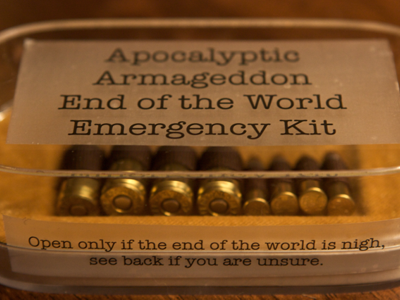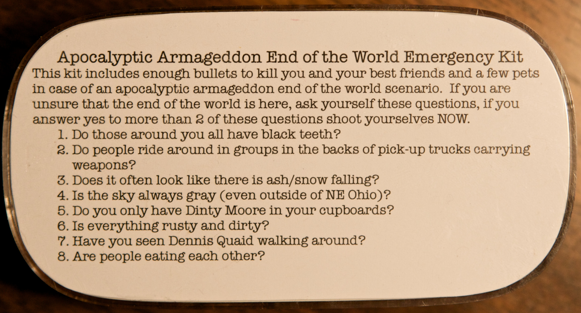
I receive a fair number of videos, emails and articles about the coming financial crash. It is always nigh. It is always imminent. And it always includes buying ammunition.
Here is the fifth piece of advice given by those anticipating a financial and societal breakdown:
5. Store food, water and firearms.
You certainly need food and water long before you need to stockpile gold.
And there are many scenarios short of the end of the world where food and water would be helpful.
 |
 |
Perhaps the most interesting part of TEOTWAWKI literature (The End Of The World As We Know It) is its application in other emergency situations.
Every survivalist has a “Bug Out Bag”. Here is Wikipedia’s description of a Bug Out Bag:
A bug-out bag is a portable kit that contains the items one would require to survive for seventy-two hours when evacuating from a disaster. The focus is on evacuation, rather than long-term survival, distinguishing the bug-out bag from a survival kit, a boating or aviation emergency kit, or a fixed-site disaster supplies kit. The kits are also popular in the survivalism subculture.
Other names for such a bag are a BOB, 72-hour kit, a grab bag, a battle box, a Personal Emergency Relocation Kits (PERK), a go bag or a GOOD bag (Get Out Of Dodge) INCHbag (I’m Never Coming Home).
One of the most useful items we learn from survivalist culture is how often preparing for TEOTWAWKI and having such a bag has helped with lesser emergencies.
But the items are certainly not limited to food, water and firearms. Here is what Wikipedia recommends for your Bug Out Bag:
The suggested contents of a bug-out bag vary, but most of the following are usually included:
- Enough food and water to last for 72 hours. This includes:Water for washing, drinking and cooking. Canada recommends 2 litres per person per day for drinking plus an additional 2 litres per person per day for cleaning and hygiene.. In addition to 6litres/6kg of water for personal hygiene for 3 days the Canadian government also recommends carrying a portable shower, nail clippers, hairbrush, cosmetics, shaving gear or beard trimmer (if electric then carry a portable generator and petrol), shampoo, deodorant, acne cream, incontinence pads, a dinner suit/gown (you never know what will happen on your adventure, it could be quite exciting, maybe a new romance). Forget trying to walk, you’ll need a car because your survival backpack will be too heavy to carry. Have a nice disaster.New Zealand recommends 3 litres per person per day for drinking. US recommends 1 gallon (3.78 litres) per person per day.
- Non-perishable food
- Water purification supplies
- Cooking supplies
- A first aid kit
- Fire starting tool (e.g., matches, ferrocerium rod, lighter, 9volt battery, etc.)
- A disaster plan including location of emergency centers, rallying points, possible evacuation routes, etc.
- Professional emergency literature explaining what to do in various types of disaster, studied and understood before the actual disaster but kept for reference
- Maps and travel information
- Standard camping equipment, including sanitation supplies
- Weather appropriate clothing (e.g., poncho, headwear, gloves, etc.)
- Bedding items such as sleeping bags and blankets
- Enough medicine to last an extended evacuation period
- Medical records
- Pet, child, and elderly care needs
- Battery or crank-operated radio
- Lighting (battery or crank operated flashlight, glow sticks)
- Cash and change, as electronic banking transactions may not be available during the initial period following an emergency or evacuation
- Positive identification, such as drivers license, state I.D. card, or social security card
- Birth certificate or passport
- Fixed-blade and folding knife
- Duct tape and rope or paracord
- Plastic tarps for shelter and water collection
- Wire for binding and animal traps
- Compass
Some users include the following. These items are appropriate and legal in some areas.
- Slingshot, pellet gun, blowgun or other small game hunting equipment[verification needed]
- Firearms and appropriate ammunition
Just to be clear. Firearms are the last item on the list, but they are on the list. There are some terrible people in this world. And you are safer when your trusted neighbors have firearms. But in most disasters, including I suspect TEOTWAWKI, most people you meet will be civil.
Still, a bug out bag is a good idea depending on where you live even if the emergency is just power outages, earthquakes and hurricanes. And with your preparedness you will be equipped to help others who might be in need.
There are many pre-made Bug Out Bags for sale on Amazon.
Here are some organizations providing resources to help you be prepared:
- Even the CDC and the Red Cross recommends: (1) Get a Kit (2) Make a Plan and (3) Be Informed.
- The American Red Cross makes family preparedness easy.
- And the Federal Emergency Management Agency (FEMA) sponsors National Preparedness Month every September.
Here is a better motto:
5. Be prepared. Especially because it keeps you from being scared.
See also all the articles in the How To Prepare For The “Coming Financial Apocalypse” series.
